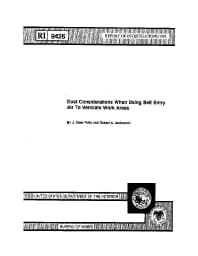Mining Publication: Dust Considerations When Using Belt Entry Air to Ventilate Work Areas
Original creation date: January 1992
Authors: JD Potts, RA Jankowski
NIOSHTIC2 Number: 10011449
Pittsburgh, PA: U.S. Department of the Interior, Bureau of Mines, RI 9426, 1992 Jan; :1-12
In this U.S. Bureau of Mines study, four underground respirable dust surveys were conducted to determine factors affecting belt entry dust levels and how using belt air to ventilate work areas affected dust exposures. Belt entry dust levels on the surveyed longwall and continuous miner sections averaged 0.59 and 0.26 Mg/m3, respectively. The stageloader-crusher contributed an additional 0.5 to 0.9 Mg/m3 of dust to belt air, while the feeder-breaker contributed 0 to 0.2 Mg/m3 of dust. A 1,000-ft increase in belt entry length or a 200- to 500-st-per-shift increase in production resulted in roughly a 0.1-Mg/m3 increase in dust. Using the belt entry as an intake entry on the continuous miner section appeared to reduce dust levels by 0.1 to 0.3 Mg/m3 during cutting. Belt air was not used to ventilate the face on the longwall section.

NIOSHTIC2 Number: 10011449
Pittsburgh, PA: U.S. Department of the Interior, Bureau of Mines, RI 9426, 1992 Jan; :1-12